Communication Client Update Settings
- The updates section of a Windows profile lets you configure how and when managed devices should check for client updates.
- You can enable automatic updates, specify which version to install, choose update frequency, and enable local updates.
|
Tip: Alternatively, you can manually update clients as follows: Click ‘Devices’ > ‘Device List’ > select target devices > Click ‘Install or Manage Packages’ > ‘Update Additional Packages’. See Remotely Install and Manage Packages on Windows Devices if you want to know more about this method. |
Configure update settings
- Open a device profile
- Click 'Add Profile Section' > 'Updates'
The section opens at the update configuration screen:
There are three tabs:
- Communication Client - Enable automatic program updates for CC and configure proxy server settings.
- Download Servers - Specify the server from which managed endpoints should collect updates.
- Open the ‘Updates’ section of a profile
- Click the 'Communication Client' tab:
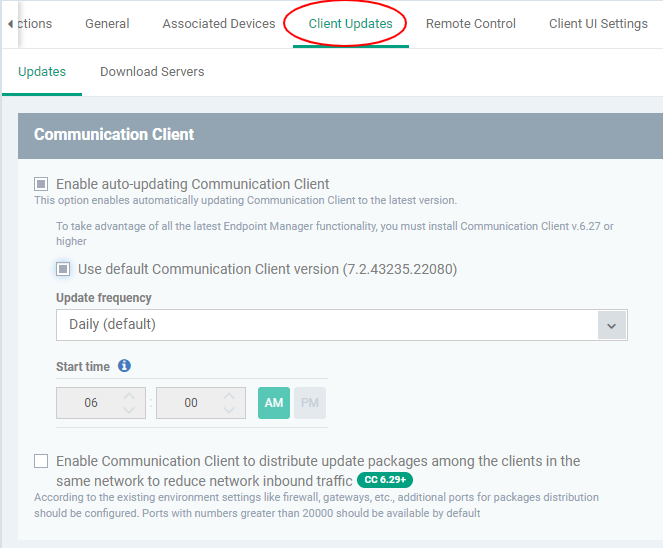
- Enable auto-updating Communication Client - Forces the endpoint to check for and install CC program updates at the selected frequency. You can set the location of the download server in the 'Download Servers' tab. Deselect if you want to disable auto updates.
- Use default Communication Client version - Choose whether or not to always update to the ‘default’ version.
- Enabled = The client will always update to the default version (Default)
- Disabled = You can choose the version to which the client updates. Make sure you choose a higher version than already installed.
Note 1. You can configure the default version in 'Settings' > 'Portal Set-up' > 'Client Settings' > 'Windows' > 'Communication Client'.
Note 2. You can only change the version if 'Change of version while updating' is enabled in 'Settings' > 'Portal Set-up' > 'Client Settings' > 'Windows' > 'Communication Client'. If it is not enabled then the default version is automatically deployed.
- Update Frequency - Choose how often CC should check for updates. The available options are:
- Daily (Default) - The client checks for updates everyday at 6:00 am.
- Daily (custom) - The client checks for updates everyday at the time you specify
- Weekly - Select the days and times that you want the client to check for updates
- On selected days - Choose one or more days in a month to check for updates. For example, you might want to update on the first and third Wednesdays of every month.
- Monthly - Select the date and time in a month to check for updates
- Enable Communication Client to distribute updates to clients in the same network - Download updates to a managed endpoint, then use that endpoint as the source from which other endpoints collect their updates.
This saves internet bandwidth usage and accelerates updates in large networks.
If enabled, your endpoint clients will follow this process at update time:
- The endpoint first checks other endpoints to see if the update is installed on them
- If available, the client fetches the update from the local endpoint
- This endpoint then becomes the source from which other endpoints collect their updates.
You can also choose the types of updates that use this mechanism:
- Communication Client updates (Version 6.29 or higher)
- Comodo Client Security updates (Version 11.4 or higher)
- Antivirus Database updates (Version 11.4 or higher)
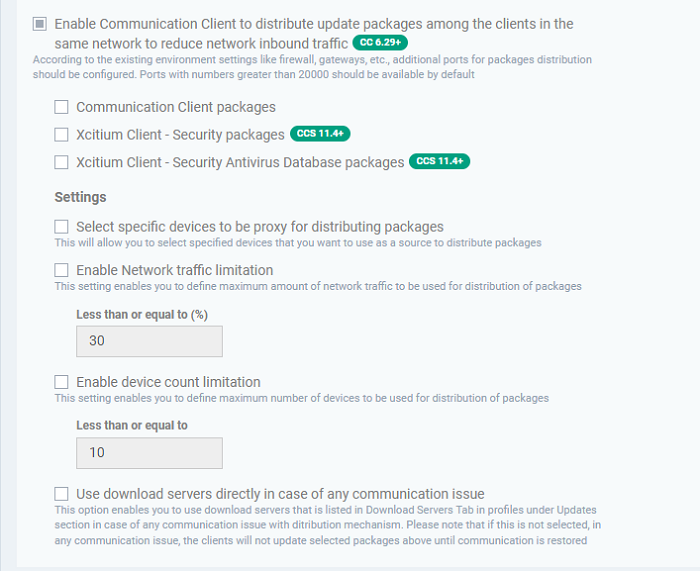
- Select specific devices to be proxy for distributing packages - Choose specific devices from which endpoints should collect updates. If you do not enable this option then any device in the local network can act as the source.
- Enter the names of the target devices in the field provided.
- You can add multiple devices as sources. Endpoints will collect from the first source they find which has the update.
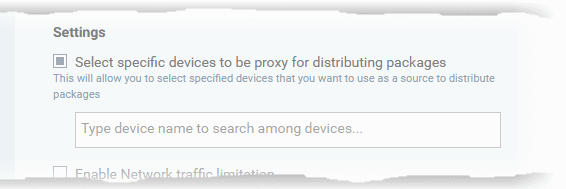
- Enable Network traffic limitation - The maximum % of network bandwidth that can be used to share updates. Default = 30%
- Enable
device count limitation - The maximum number of devices with which the client is allowed to simultaneously share updates. (Default = 10, Maximum = 20).
- Use download servers directly in case of any communication issue - If the endpoint cannot contact other endpoints it will instead collect the update from the server in the 'Download Servers' tab.
- Click 'Save'.
|
|
Options |
Client fetches update from: |
||
|---|---|---|---|---|
|
Enable Communication Client to distribute ... |
Select specific devices to be proxy ... |
Use download servers directly in case of ... |
||
|
Scenario 1 |
Any local device which already has the update |
|||
|
Scenario 2 |
Only from selected devices |
|||
|
Scenario 3 |
1. Any device in the local network 2. Download servers |
|||
|
Scenario 4 |
1. Selected devices 2. Download servers |
|||
|
Additional Notes:
|
Download Server
- The 'Download Servers' tab lets you add and select the servers from which endpoints should collect updates.
- You may wish to first download updates to a proxy/staging server and have endpoints collect updates from there. This helps conserve overall bandwidth consumption and accelerates the update process when large number of endpoints are involved.
- You can configure different proxy servers for Comodo Client Security and the Communication Client.
|
Note: You need to install the 'ESM Update Mirror' utility on the proxy servers in order to get regular updates from Comodo.
|
- Click the 'Download Servers' tab
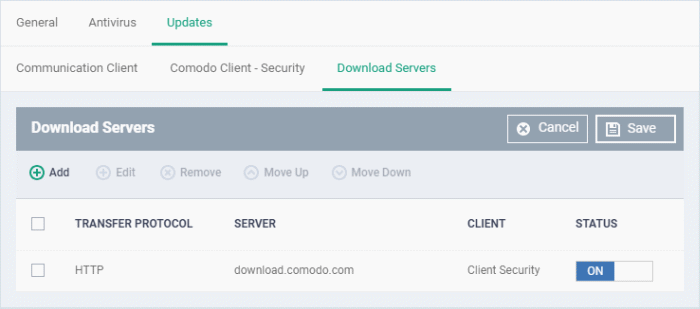
By default, EM is set to download updates from the Comodo servers. You can add your local servers here, edit, reorder the list of servers and remove servers if required.
- Click 'Add' to add a server
The 'Add Server' dialog will be displayed.
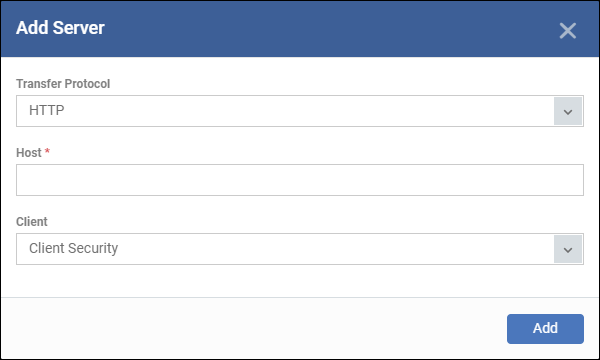
- Transfer Protocol - Select HTTP or HTTPS
- Host - Enter the server details in the 'Host' field, either IP or the host name.
- Client - Select which items should be collected from the proxy:
- Communication Client - Endpoints will collect communication client (CC) updates from the proxy server.
- Client Security - Endpoints will collect security client (CCS) updates from the proxy server, including virus database updates.
- Communication Client + Client Security - Endpoints will collect CC, CCS, and virus database updates from the proxy.
- Click 'Add'. Repeat the process to add more servers.
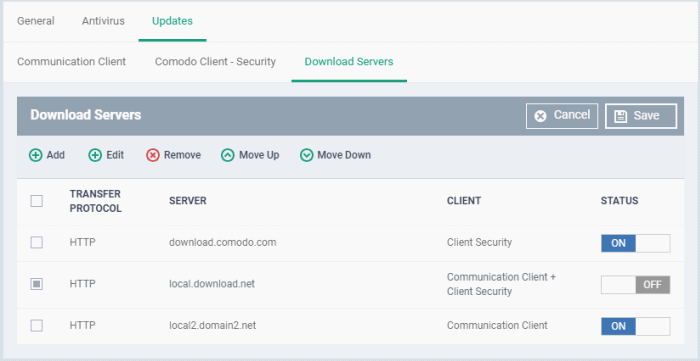
- Use the 'on-off' switch to enable or disable a server. You need to enable the server in order for endpoints to use it
You can edit, remove or reorder the list of servers.
- To edit a server details, select it and click the 'Edit' button at the top
- Update the details as required and click the 'Set' button
- To remove a server, select it and click 'Remove' at the top
The updates are checked from the server at the top and moves down the list. You can reorder the list of servers.
- To reorder the server list, select the server(s) and click 'Move Up' or 'Move Down'
- Click
'Save' for the changes to updated in the profile.


